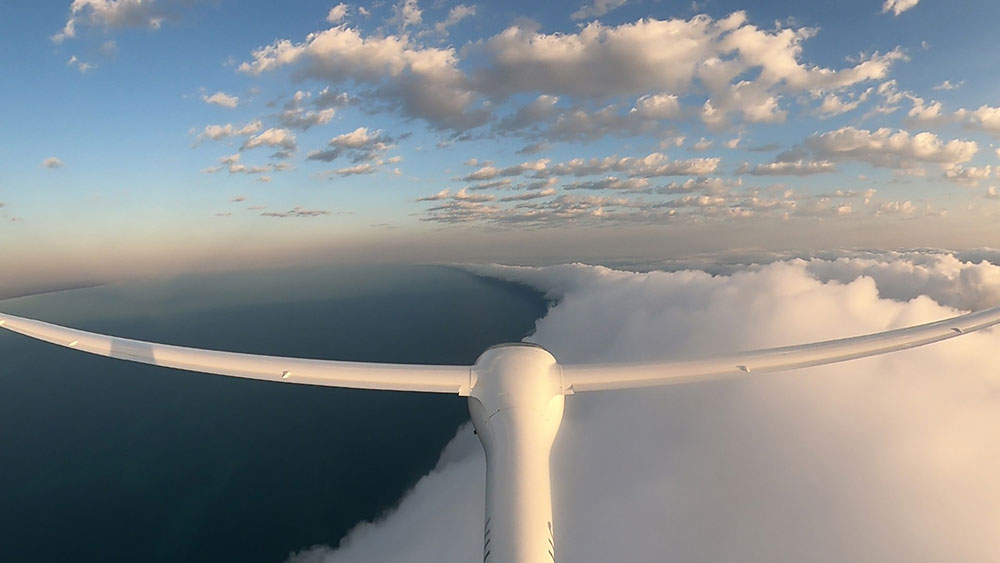
Flying over the Apennines near Pavullo.
By Sean Young
The final competition of Series 11 Sailplane Grand Prix took place at the small town of Pavullo Nel Frignano, nestled in the Northern Apennine Mountains near the cities of Modena and Bologna, Italy. After a series of contest heats including Gawler last January, the SGP Final determines the SGP World Champion.
An essential element of the SGP concept is live tracking, broadcast via YouTube with live commentary. All pilots are following the same course and all fly similar 18m gliders with 48kg wing loading. The live tracking with 3D simulation is very entertaining and enables everyone to follow the short races as if they were on the race track.
The dedicated team led by Brian Spreckley, who will be Chief Steward at WGC Narromine in December, provided professional and comprehensive video coverage of the contest.
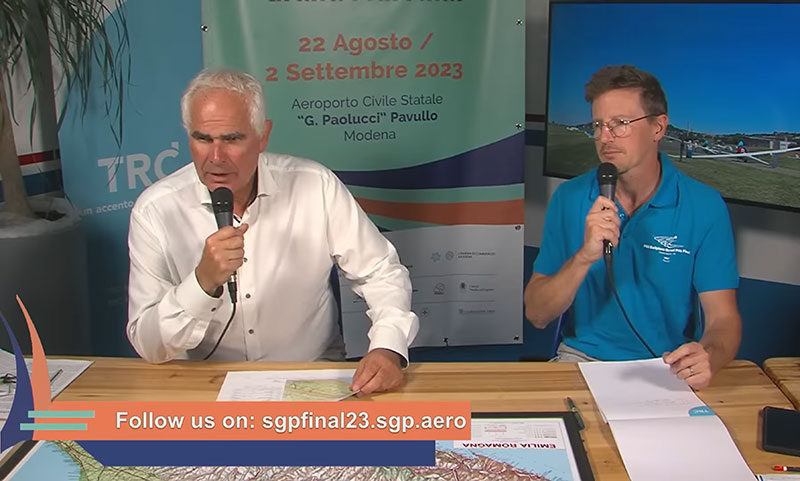
Commentators Stefano Ghirizo and Benjamin Neglais calling the race as it happened.
GP Basics
The week long competition started with three no fly days, which gave me time to explore the friendly town and to experience how enmeshed Pavullo Airport is with the area and its population. Unlike many airfields that seem distant and outside of town, and are seldom visited, Pavullo Airfield is a vital part of the culture and amenity of the district. I think there are some lessons we in Australia can learn from their experience. But more of that later – first, the SGP Racing action.
The Grand Prix format has become very popular for gliding competitions in Australia. For example, the recent Queensland State Championships was held in a Grand Prix format. The rules are not complicated. Basically, all the gliders start in a line at the same time. The first glider to cross the finish line is the winner, gaining 10 points, while the next nine pilots across the line each gain progressively fewer points, from 9 down to 1 point for the 10th pilot.
Unless, that is, penalties are applied for low finishes, airspace infringements or other errors. There were quite a few penalties during these championships, particularly on the final day.
Nineteen pilots from 10 countries competed for the title of SGP World Champion. After three days of no flying, the first race was held in marginal weather. However, all the contestants completed the task and Stefan Langer, who will be competing for Germany at WGC Narromine, took first place.
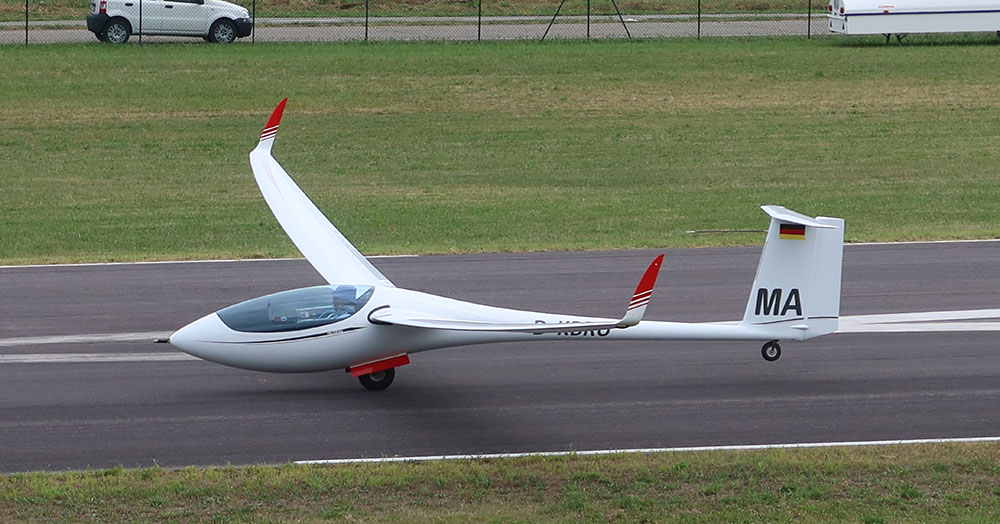
Italian pilot Alberto Sironi taking off in his AS33 on the final day of the competition.

Competitors with Thomas Gostner at the front, contemplating the conditions for the day.
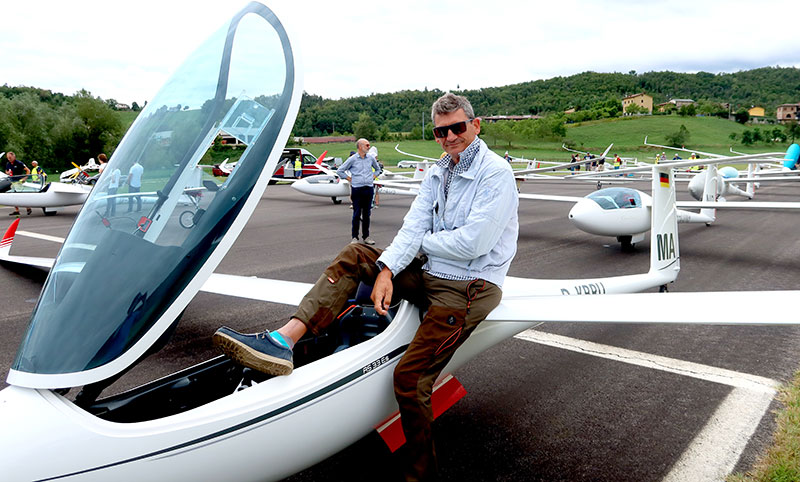
Alberto Sironi on the grid.
Ultimate Race
Over the following three days, the conditions continued to improve day by day and three more exciting races were held. On the final day the weather was excellent with CUs over the mountain ridges and no adverse weather forecast.
The fleet launched on the final race with cumulus popping above Pavullo airport. Nine of the pilots were very close in the scoring and any one of them could have taken the championship if they had won the day and gained the 11 points that the first pilot would be awarded for the final race. The task was 248km in good mountain soaring conditions.
Sebastian Kawa, who will be defending his 15m World Championship title at WGC Narromine, had a strong start and climbed high, which enabled him to take the further side of the ridge from the rest of the fleet and push into the lead.
As they headed into the first turnpoint, Kawa was in the lead at 6,500ft followed by Alberto Sironi, while the main group were 2,000ft below at around 4,000ft.
Stefan Langer was low and appeared to be struggling, probably because he had tried a different track. Tilo Holighaus was also lower and towards the rear of the fleet. But previous World Champion, local pilot and commentator Stefano Ghirizo said, 'The critical point on this task is the second turnpoint.’
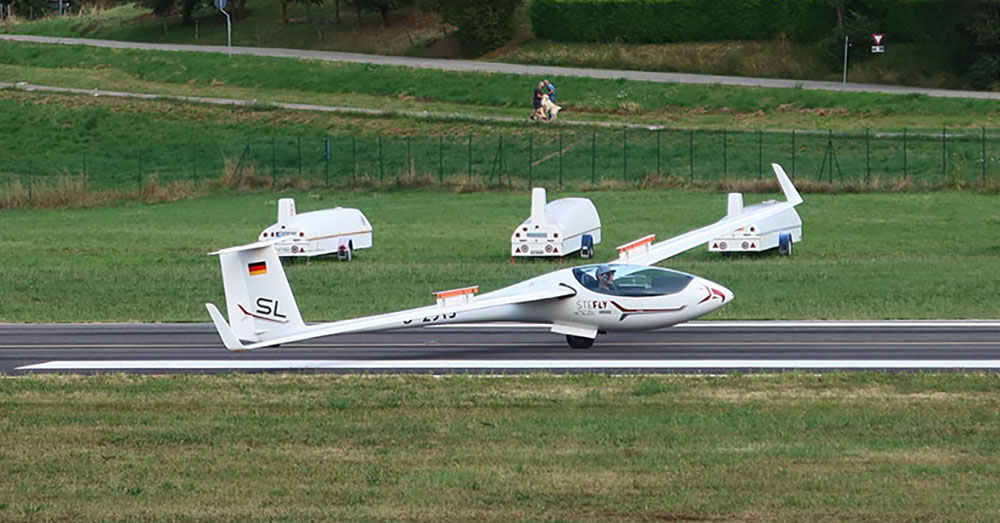
Stefan Langer landing his ASG29 to win the competiton.
Confusion
As Kawa reached the first turnpoint, Langer and Giles Navas had also climbed up to above 7,000ft. Kawa had flown a convergence line without turning since his first climb and was in a strong leading position, but closely followed by Alberto Sironi.
On the second leg, Kawa flew east of track following the ridge line. This leg was only 11km but it looked as if he had made a mistake and was flying to the wrong turnpoint, leaving Sironi in the lead. Kawa soon changed direction but lost his lead position.
Sironi turned the second turnpoint well ahead of Luka Znidarsic and Maximillain Seis. The remainder of the fleet were strung out with Mike Young at the back.
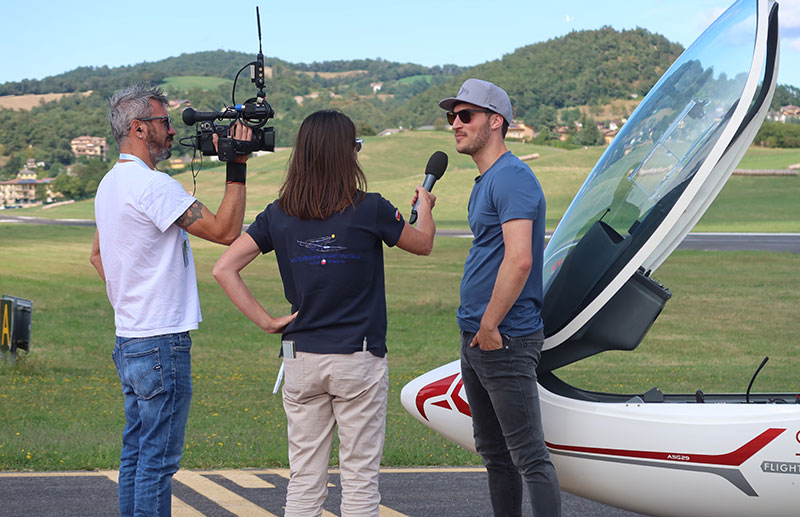
Claire Heliot interviews Stefan Langer after landing.
The third leg was 117km and Sironi was over 8,000ft, followed by Dirk Windmüller who had yet to score any points in the contest.
Halfway down the leg, Sironi held onto his lead followed by Seis and now closely followed by Langer and Thomas Gostner. But Sironi eventually got lower down to 5,000ft, while Gostner found a strong climb to over 8,000ft in the company of Hermann Leucker, putting them in a good position to catch Sironi.

Contest Director Brian Spreckley discusses the task with task setter and commentator
Stefano Ghirizo and Benjamin Neglais.
Shifting Positions
Sironi made the third turnpoint first and soon stopped to climb. Gostner was in a very good position. He was higher with no need to climb as they started down the 48km fourth leg followed by a 6km dash to the finish. Gostner stopped to gain even more height to over 7,000ft while Sironi was now in a bad position at 3,000ft although he was still in the lead. A large group of pilots were behind Gostner with good altitude as he went into the turnpoint.
Sironi eventually found a climb with about 55km to go and, slightly later with 40km left in the race, managed to keep his lead by following a good line of energy while Gostner no longer had an altitude advantage. Hermann Luucker meanwhile reached final climb altitude, enabling him to head straight for the finish.
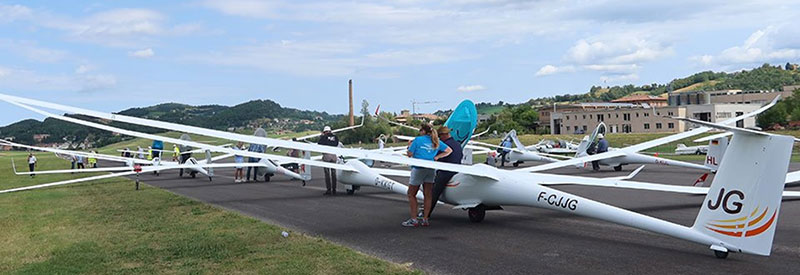
Competitors on the grid at Pavullo Airfield.
Energy Lines
As Sironi approached final glide altitude, he and Gostner were 3km apart. While these two pilots searched for good energy lines to get enough altitude to get home, the next group of pilots had final glide and were able to fly faster and quickly gained on the leaders.
Gostner found better energy as they approached the final turnpoint. But Sironi climbed on the final ridge before the final turn as Gostner quickly came up to him. Gostner ended up a bit higher and half a kilometre ahead and the dash to the finish between these two pilots was on.
Gostner beat Sironi to the line, but this is where penalty points became critical and changed the outcome of the contest. Perhaps these two pilots were caught up by their determination to best each other, but they seemed to forget they had to stay within the parameters of the race.
Thomas Gostner incurred 84 seconds penalty and Albert Sironi 274 seconds penalty for crossing the finish line too low. In fact, nine of the pilots incurred various penalty points. This did not just change the declared winner on the day but the overall championship scores.
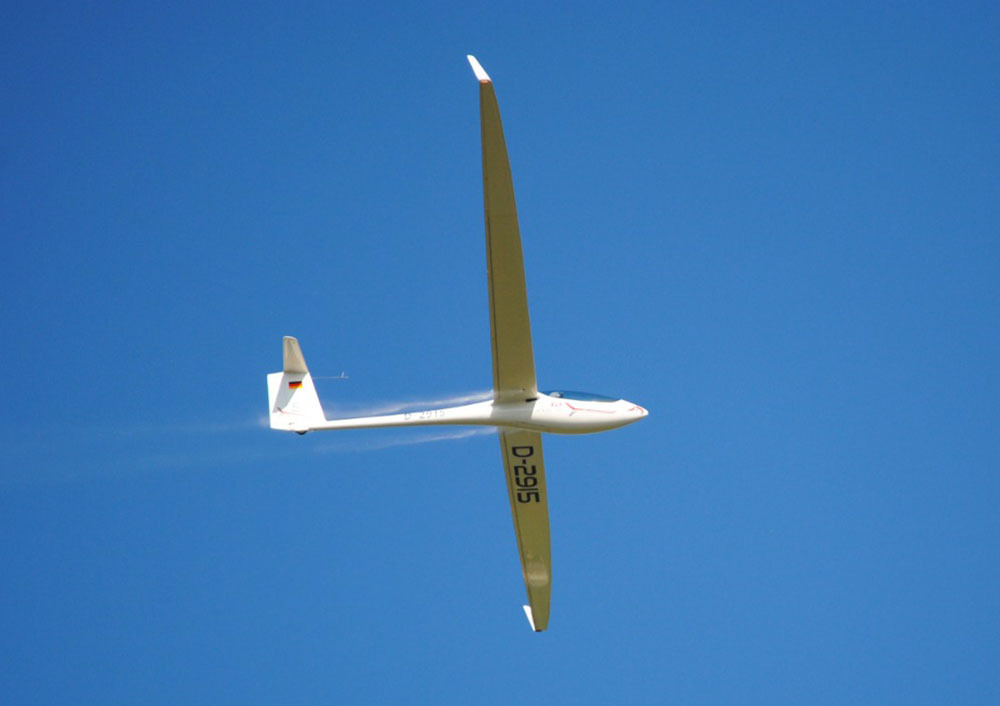
Flying across the finishline, which aligned with the middle point of the runway, made for a spectacular end to the race day.
A New Champion
When the gliders were put away, all the penalties were calculated, challenged and finalised, it was Stefan Langer who emerged as the winner, finishing the championship in first place. After penalties, he had come 9th in the final race and scored just 1 additional point.
Erik Borgmann, who had incurred 16 seconds penalty in the final race but took 3rd place on the day, took 2nd place overall followed by Hermann Leucker in 3rd position.
It was exciting racing but, as is so often the case, it is the pilot with a consistently high performance that wins a multi day championship. WGC Narromine will take place over two weeks with a potential 14 racing days. Stefan Langer will be flying in Club Class and Sebastian Kawa in 15M Class so we will not see these two champions race against each other. It will be a marathon and it will be, as always, fascinating to see how the best pilots in the world perform.
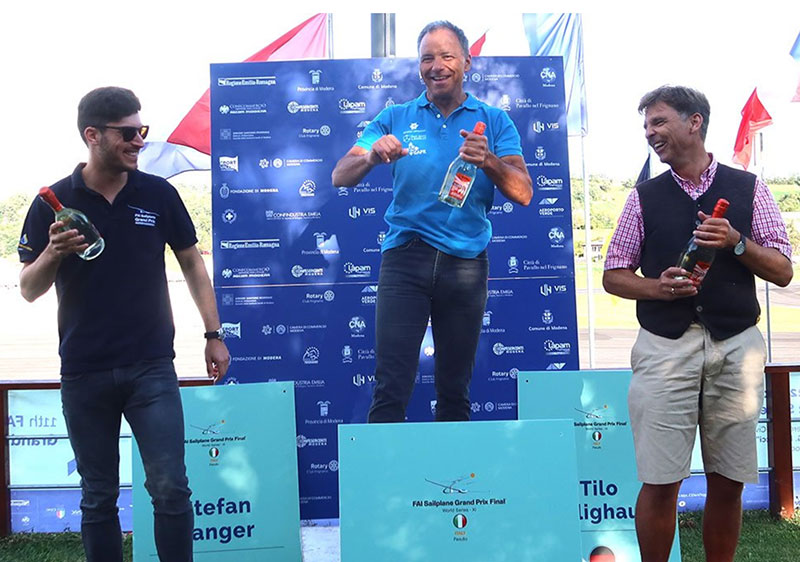
On the podium after Race 2, the eventual winner Stefan Langer celebrates with Sebastian Kawa and Tilo Holighaus.
Pavullo Airfield
Pavullo is an airfield with a long history dating back to the 1920s. It is owned by the Aero Club Pavullo and is located just outside the town in a lovely setting. Around the entire circumference of the aerodrome is a picturesque walking, jogging and bicycle track. Next to the club house is a bar and bistro and an outdoor cafe.
The track was built just a few years ago when the Aero Club wanted to engage more with the local population. The members proposed creating the track so that the airfield would become a community resource, rather than being perceived as a nuisance with aircraft noise creating a constant drone.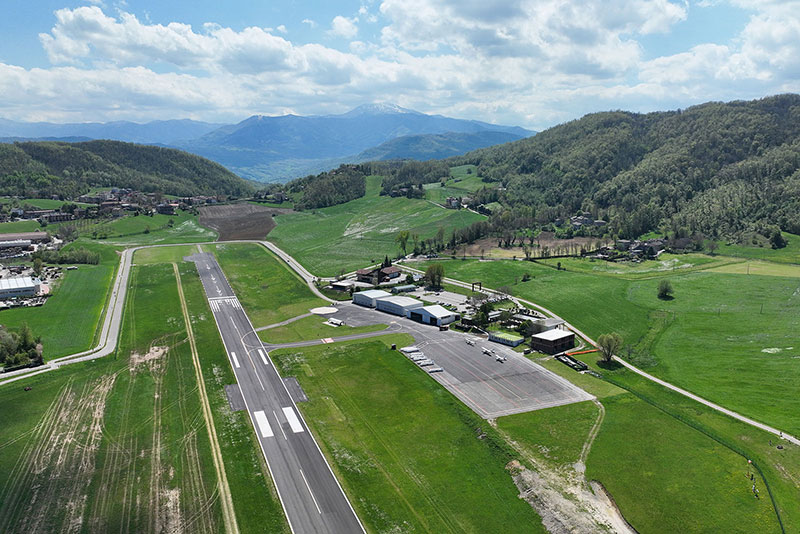
Pavullo Airfield, where the perimeter road has been converted to a jogging and bicycle track.
I don't know how it was funded, but it received government support and the results have been a tremendous success. From early morning to late in the evening, a constant stream of townsfolk come out to exercise on foot, bicycles or even pulled along on skateboards by pet dogs. Groups gather to watch aircraft take off and land in the evening light. The airfield is now part of the community and used by many.
At any time of day, people can pause their exercise and meet for a coffee, snack or a full meal. On Saturday and Sunday the bistro and cafe are buzzing and filled with families, grandparents, parents and children enjoying the convivial atmosphere. The Aero Club provides space for many events such as car displays and numerous other club orientated events. They also have convention facilities that they rent out.
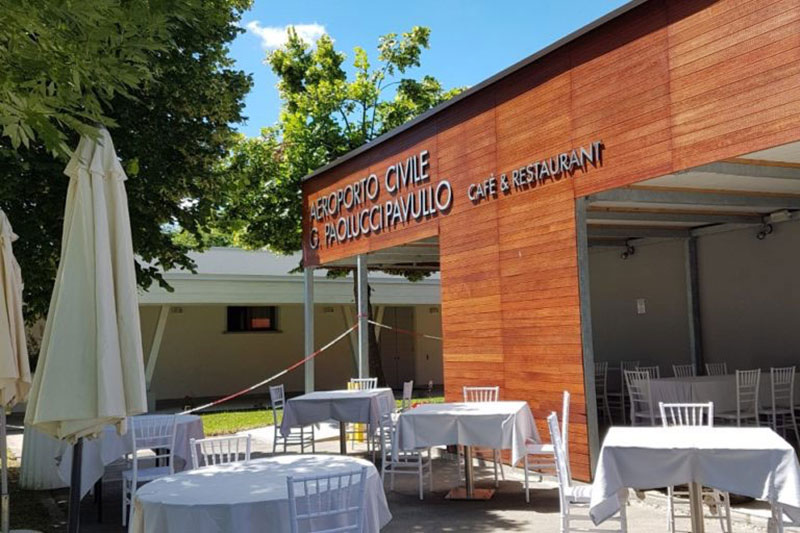
The Airfield has excellent cafe and restaurant facilities.
I believe that we can learn from their successful example. Italy is smaller and more populous than Australia. Pavullo although not served well by public transport is nevertheless not remote. However, I think that whatever we can do to welcome local communities to our clubs and airfields will not only improve the experience of gliding club members, but also our relationship with the local community.
It will also pay dividends in terms of greater local acceptance and integration. If we are able to enhance the amenity of our club facilities, they will be more attractive to younger and more diverse groups of people. Improvements and added facilities will also make our clubs more likely to attract and retain members. Any ideas we have that will improve how we are perceived by visitors will aid our long term viability.
FAI Sailplane Grand Prix - Series XI
World Final Pavullo Italy
26 August - 2 September 2023
1. Stefan Langer GER ASG29 19 pts
2. Erik Borgmann NED JS3 19 pts
5. Hermann leuker ger js3 18 pts
You can see the full race results at
sgpfinal23.sgp.aero/results
Video Coverage at YouTube tinyurl.com/yucyc8f3































